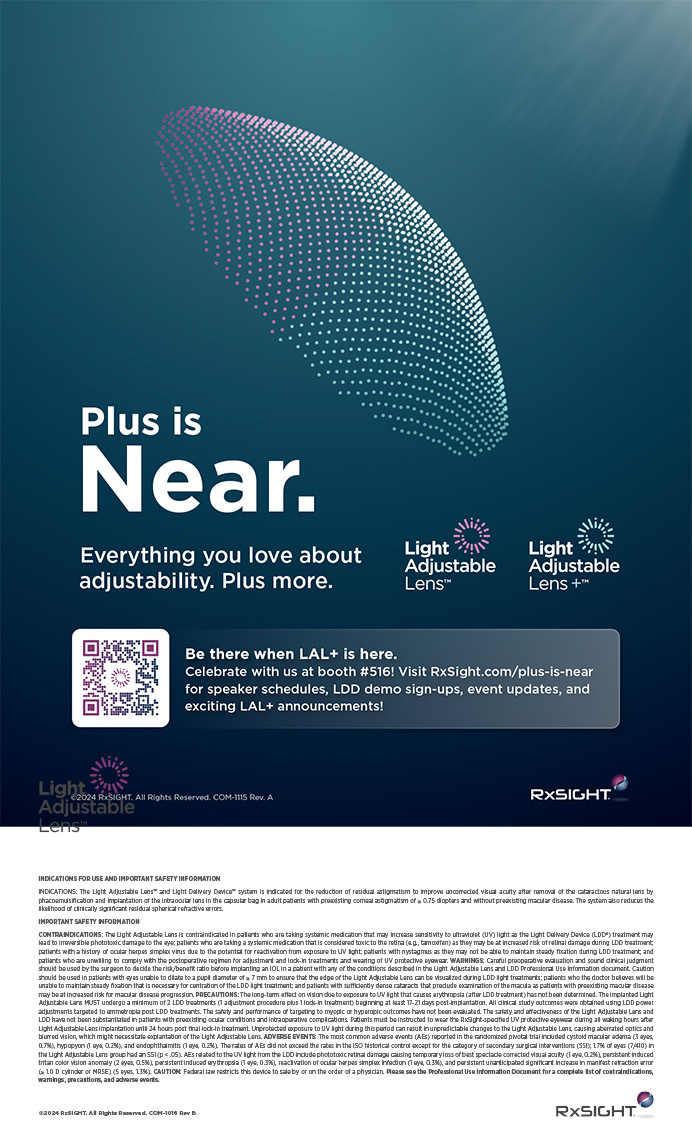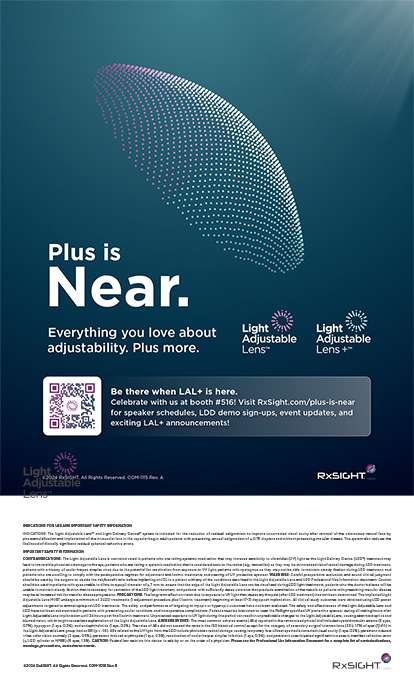The safety and efficacy of endoscopic cyclophotocoagulation (ECP) for lowering IOP has been confirmed by several long-term studies.1-3 Because this technology allows the surgeon to visualize and apply diode laser energy directly and precisely to the ciliary processes, it is less likely to produce the pain, inflammation, hypotony, and visual loss that can occur with transscleral cycloablation. In addition, ECP's intraocular approach allows surgeons to combine this ablative procedure with phacoemulsification, thus lowering IOP and reducing the need for medications in patients with cataracts and medically controlled glaucoma. This article describes the surgical technique of ECP and provides pearls for its use in combined procedures.
TECHNIQUES
Equipment
The technology for ECP consists of an 18-gauge multifunctional endoscopic probe and a freestanding console. The endoscope houses three groups of fibers that allow surgeons to image, illuminate, and ablate structures in the anterior chamber (Figure 1).
The console contains all of the instruments necessary for endoscopy—a video camera/monitor/recorder as well as an 810-nm semiconductor diode laser. Once inside the eye, the probe displays a panoramic view (110° field of view with a depth of focus from 1 to 30 mm) of the anterior chamber and ciliary processes on a video monitor. This setup allows surgeons to view the operative field and to control the procedure without looking through a surgical microscope. Surgeons can access the ciliary processes by inserting the probe into the anterior chamber through a 1.5- to 2.0-mm clear corneal incision or a scleral tunnel. A clear corneal incision is preferable, because it leaves the superior part of the conjunctiva intact for future filtering surgery.
Order of Operations
ECP can be performed in phakic, pseudophakic, or aphakic eyes. During combined procedures, surgeons can execute phacoemulsification in their usual manner and perform ECP either before or after the PCIOL's insertion in the capsular bag.
The introduction of a cohesive ophthalmic viscosurgical device between the capsular bag and iris will move the former structure posteriorly and the latter anteriorly. This step thus provides a clear view of the ciliary processes.
Photocoagulation
ECP technology allows the delivery of titratable laser energy directly to the ciliary processes. During the procedure, surgeons should treat 200° to 360° of the ciliary body by sequentially applying energy to the entire surface of each process until the tissue visibly shrinks and turns white (Figure 2). Signs of overtreatment include the formation of gas bubbles, the dispersion of pigment, and the popping of the ciliary process. Surgeons should try to avoid applying energy to nonciliary tissues, treating prosthetic materials, and leaving viscoelastic in the eye at the conclusion of the procedure. The last factor is crucial for preventing postoperative IOP spikes.
PATIENT SELECTION
Laser endoscopy permits ophthalmologists to visualize and photocoagulate the ciliary processes in almost every eye, even those with corneal opacification, miotic pupils, or a history of glaucoma surgery.1 Surgeons should consider ECP for patients who are poor candidates for filtering surgery or drainage devices due to scarred conjunctivae or a history of complicated trabeculectomy in their contralateral eye. Bleb-related contraindications for penetrating surgery include flattening of the anterior chamber, chronic choroidal detachment, hypotony, leaking or dysesthetic blebs, blebitis, endophthalmitis, expulsive hemorrhage, suprachoroidal hemorrhage, and excessive astigmatism.4
Surgeons may also consider ECP for patients who have intraocular tumors, blepharitis, a history of ocular fistulae secondary to elevated episcleral venous pressure, or a history of wearing contact lenses. Compared with penetrating glaucoma surgery, ECP takes less time to complete, requires fewer follow-up visits, and is associated with a lower incidence of postoperative manipulations (eg, laser suture lysis, bleb needling, injections of 5-fluorouracil). Likewise, ECP is an alternative for patients who previously experienced problems with glaucoma drainage devices such as dysfunction of the extraocular muscles, erosion of the device's tube or plate, or corneal decompensation.
COMBINED SURGERY
Many of the 3 million patients who undergo cataract surgery each year are also being treated for glaucoma. Every time one of these patients presents for cataract extraction, surgeons must decide whether to perform phacoemulsification alone or to combine phacoemulsification with a surgical treatment for glaucoma.
Before 1998, my only option for the simultaneous treatment of cataracts and glaucoma was combined phacoemulsification and trabeculectomy. Although some patients experienced a modest decrease in IOP after phacoemulsification alone, most of them continued to use the same number of medications postoperatively. Some glaucoma patients' IOPs remained the same or became elevated after phacoemulsification. Those who experienced a rise in IOP after cataract surgery often required subsequent trabeculectomy. My findings are consistent with those reported in the literature.5,6
Since 1998, my partners and I have performed more than 1,000 cases of combined phacoemulsification/ECP, primarily in patients with medically controlled glaucoma. A 12-month analysis of our first 25 consecutive cases showed that treating 180° of the ciliary body reduced IOP by a mean of 15% (from 20.2 to 17.2 mm Hg). We also observed that patients who underwent combined surgery used fewer glaucoma medications postoperatively (1.6 to 0.5; 68%). None of the treated patients lost vision or reported significant sequelae postoperatively.7
In other words, ECP would lower the IOP of a typical patient from 20 to 17 mm Hg and reduce the number of medications he or she used from three preoperatively to one postoperatively. Both patients and surgeons could benefit from the therapeutic effect of ECP, because fewer medicines mean lower costs, a more convenient dosing schedule, a lower risk of local and systemic side effects, and thus possibly improved adherence to medical therapy.
My colleagues and I recently compared the long-term outcomes (mean follow-up, 3.2 years) of 626 consecutive eyes treated with combined phacoemulsification/ECP and 81 eyes treated with phacoemulsification alone.2 Our analysis showed that IOP decreased by a mean of 3.4 mm Hg (19.1 to 15.7 mm Hg) in the combined-treatment group versus a 0.7 mm Hg increase (18.2 to 18.9 mm Hg) in the phacoemulsification-only group (Figure 3). More significantly, the number of glaucoma medications used by patients decreased from a mean of 1.53 preoperatively to 0.65 at last follow-up in the combined- treatment group but remained unchanged from a mean of 1.20 in the phacoemulsification-only group.2
We did not observe any serious complications in either group, and fewer than 1% of eyes in both groups developed postoperative cystoid macular edema.
A study of more than 1,000 eyes confirmed the results of our analysis and demonstrated no difference in the incidence of cystoid macular edema between eyes treated with combined phacoemulsification/ECP and phacoemulsification alone (approximately 2% in both groups).3
WHEN IS ECP APPROPRIATE?
I do not perform combined phacoemulsification/ECP on every glaucoma patient undergoing cataract surgery. I treat approximately 25% of the glaucoma patients in my practice with phacoemulsification alone, 50% with combined phacoemulsification/ECP, and 25% with phacoemulsification/trabeculectomy. Although I evaluate every patient individually, my general rule of thumb is as follows.8-10
If a patient with a cataract has mild, well-controlled glaucoma on a single, well-tolerated glaucoma medication, I will perform phacoemulsification alone through a clear corneal temporal incision. This approach preserves the superior conjunctiva for possible future trabeculectomy. If the patient has moderate glaucoma and uses two or more medications, I perform phacoemulsification/ECP through a clear corneal incision. My goal is to lower his or her IOP and to reduce the number of medications needed. As with the first scenario, the clear corneal incision preserves the conjunctiva for possible future trabeculectomy. If a patient has advanced glaucomatous cupping and visual field loss on maximum medical therapy (two or more medications), I perform phacotrabeculectomy with adjunctive mitomycin C.
CONCLUSION
ECP may not be appropriate for cataract patients with very mild or very advanced glaucoma, but it is a simple and easy surgical treatment for patients with moderate glaucoma who routinely use two or more medications.
Stanley J. Berke, MD, is an associate clinical professor of ophthalmology and visual sciences at the Albert Einstein College of Medicine in New York City, and he is the chief of the Glaucoma Service at Nassau University Medical Center in East Meadow, New York. Dr. Berke is a founding partner of Ophthalmic Consultants of Long Island in Lynbrook, New York. He acknowledged no financial interest in the product or company mentioned herein. Dr. Berke may be reached at (516) 593-7709 ext. 207; sberke@ocli.net.


